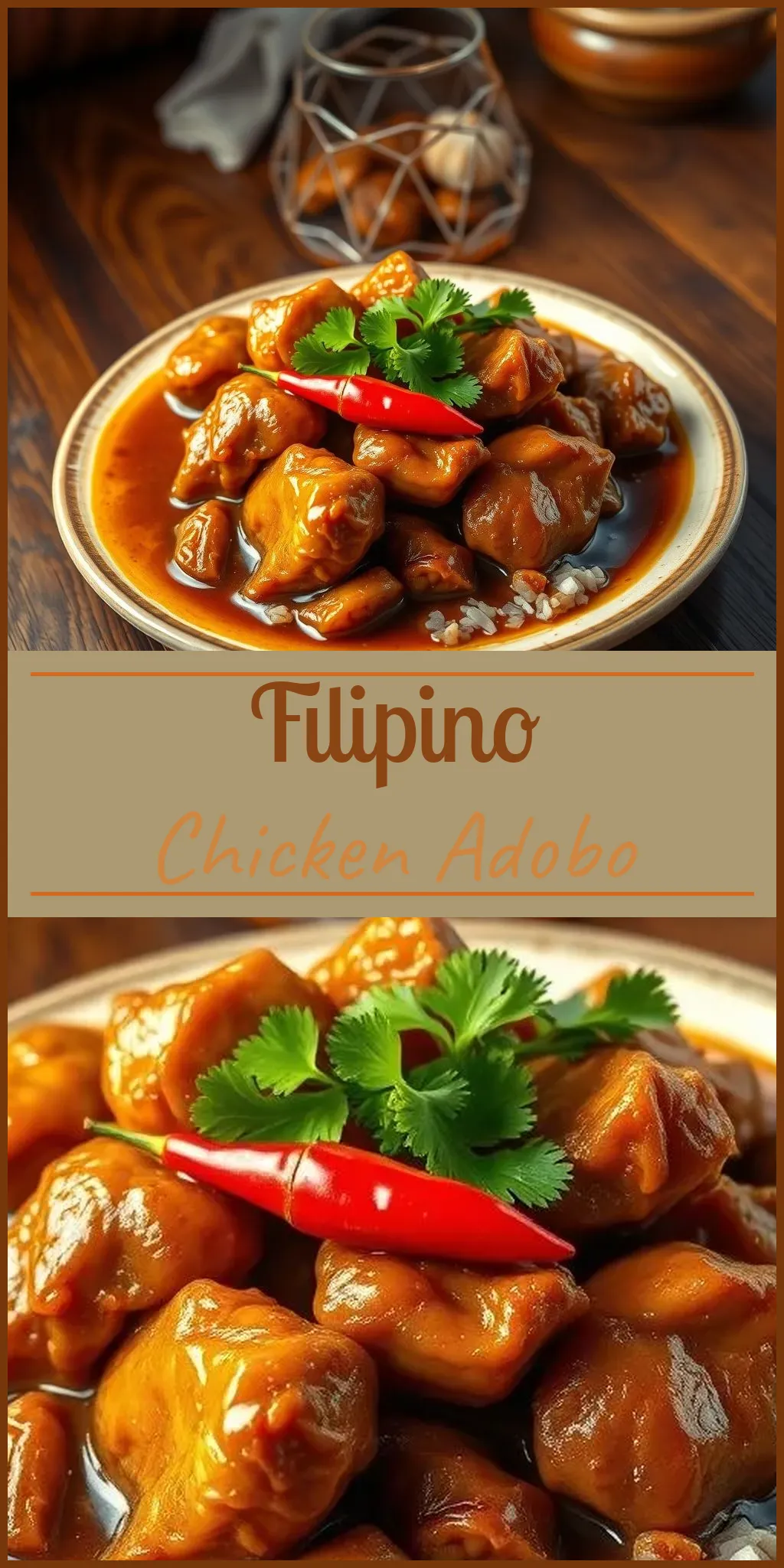Filipino Chicken Adobo is one of the most cherished dishes in Filipino cuisine. Its blend of tangy vinegar, savory soy sauce, and aromatic spices creates a harmonious flavor profile. In this article, we explore every aspect of this classic dish—from its historical roots to practical tips and variations—to help you create a memorable meal. Let’s dive into the world of Filipino culinary traditions.
Introduction to Filipino Chicken Adobo
Filipino Chicken Adobo has been a household staple for generations. Originally, it served as a practical way to preserve meat. Today, it stands as a symbol of cultural heritage and culinary creativity. The art of combining soy sauce and vinegar with garlic, bay leaves, and peppercorns results in tender chicken that bursts with flavor.
In many Filipino homes, adobo is prepared with unique personal touches. Some families prefer a longer marinating process, while others simmer the sauce to a rich glaze. Whether you enjoy a tangy bite or a slightly sweet twist, you will find that this dish is incredibly versatile.

The Ingredients
The magic of Filipino Chicken Adobo lies in its straightforward ingredients. Each component contributes to a balanced and complex taste. Below is a detailed list of what you’ll need:
Chicken and Marinade
- Bone-In Chicken Pieces: Choose a mix of thighs, legs, and wings. Bone-in chicken enhances the flavor.
- Soy Sauce: This key ingredient provides umami and a rich, savory taste. Filipino brands are ideal for authenticity.
- Vinegar: Cane vinegar is preferred for its mild, balanced flavor. White vinegar is a good alternative.
- Crushed Garlic: Fresh garlic releases essential oils and deep flavor.
- Cracked Black Peppercorns: For a touch of spice and aromatic depth.
- Bay Leaves: They lend a subtle herbal essence that elevates the dish.
- Sugar (Optional): A small amount of sugar balances the acidity.
Accompaniments
- Steamed White Rice: A necessary partner to soak up the delicious sauce.
- Fresh Vegetables: Optional garnishes like sliced scallions or cucumber can brighten the plate.
How to Make Filipino Chicken Adobo
Creating authentic chicken adobo is a process that rewards patience and attention. Follow these steps closely:
Step 1: Marinate the Chicken
Start by preparing your ingredients:
- Cut and Clean
- Rinse your bone-in chicken pieces.
-
Pat dry with paper towels for better browning.
-
Combine the Marinade
- In a large bowl, mix equal parts soy sauce and vinegar.
- Add crushed garlic, cracked black peppercorns, and bay leaves.
-
Optionally, stir in a pinch of sugar.
-
Marinate Thoroughly
- Place the chicken pieces in the bowl.
- Allow the chicken to marinate for at least 30 minutes.
Tip: Longer marination intensifies the flavors even further.
Step 2: Braise the Chicken
After marination, it is time to simmer and reduce the sauce:
- Sear the Chicken (Optional Step)
- Lightly sear the marinated chicken in a hot skillet to develop a golden crust.
-
This step takes about 5 minutes per side and adds extra flavor.
-
Combine and Simmer
- Transfer the seared chicken and the marinade into a large pot or deep skillet.
- Bring the mixture to a boil over medium heat.
- Once boiling, lower the heat and allow the chicken to simmer.
-
Cover the pot and cook for 30 minutes.
-
Reduce the Sauce
- Uncover the pot, and let the sauce continue simmering for another 20 minutes.
- Stir occasionally, allowing the marinade to reduce to a thick, concentrated glaze that clings to the chicken.
Step 3: Serve and Enjoy
Having simmered to perfection, your adobo is nearly complete:
- Plate the Chicken:
Serve the tender chicken pieces atop a bed of steamed white rice. - Sauce It Up:
Generously drizzle the reduced sauce over the rice. - Garnish:
Add a sprinkle of chopped scallions or a side of sautéed vegetables if desired.
Every bite rewards you with a burst of tangy, savory goodness that warms the heart and pleases the palate.
Tips for the Best Chicken Adobo
Mastering Filipino Chicken Adobo is all about technique and balance. Here are some tips to ensure your dish turns out perfectly every time:
- Use Bone-In Chicken:
Bone-in pieces provide extra flavor. The bones deepen the taste as they release collagen during cooking. - Balance the Marinade:
Adjust the soy sauce and vinegar according to your taste. If the vinegar is too strong, add a bit more soy sauce to balance it out. - Monitor the Simmer:
Maintain a gentle simmer rather than a vigorous boil. This slow cooking helps tenderize the chicken evenly. - Experiment with Time:
Feel free to marinate the chicken for longer if time permits. Some recipes suggest overnight marination for maximum flavor infusion. - Optional Searing:
Although not essential, briefly browning the chicken enhances the texture and adds a layer of flavor.
Variations of Filipino Adobo
Filipino adobo is a versatile recipe that permits creative tweaks while staying true to its roots. Explore these popular variations to find your ideal version:
Pork Adobo
Replace chicken with cubes of fatty pork shoulder. Pork adobo offers a richer taste and a different texture. It blends perfectly with the tangy sauce.
Adobo With Pineapple
For a tropical twist, add pineapple chunks and a splash of pineapple juice. This variation introduces a light sweetness that aids in cutting the vinegar’s sharpness.
Adobo with Boiled Eggs
Enhance your dish with hard-boiled eggs. Let the eggs simmer in the adobo sauce during the final few minutes. They absorb the flavors wonderfully, adding protein and a new texture.
Mixed Meats
Combine chicken and pork in one pot. The blend of meats creates a multifaceted flavor experience. Experiment to see which ratios suit your taste best.
Leftover Ideas: No Food Is Ever Wasted
One of the standout features of adobo is its ability to improve in flavor when reheated. Here are several creative ideas for using leftovers:
- Adobo Fried Rice:
Shred the chicken and mix it with rice and some leftover sauce. Stir-fry until everything is heated through. - Adobo Sandwich:
Use the shredded chicken as a filling in a sandwich. Add a dollop of mayo and crunch with fresh lettuce. - Crispy Adobo Flakes:
Fry shredded chicken until it turns crispy. Serve with a side of rice and a fried egg for a fulfilling meal.
Using leftovers not only reduces waste, but it also allows you to enjoy the dish in new ways. These ideas provide extra value and variety to your culinary repertoire.
Storing and Reheating Your Adobo
Filipino Chicken Adobo is an excellent make-ahead meal. Here’s how to store it for optimal taste and safety:
Refrigeration
- Cool Down:
Allow the adobo to cool completely before storing. - Storage Container:
Use an airtight container to keep the flavors locked in. - Duration:
Refrigerate for up to 4 days. Reheating in a microwave or stovetop works perfectly.
Freezing
- Freeze Safely:
Transfer the cooled adobo into a freezer-safe container. - Shelf Life:
It can be frozen for up to 4 months. - Thawing:
Thaw overnight in your refrigerator or leave at room temperature for about 30 minutes before reheating.
Frequently Asked Questions (FAQs)
Below are some common questions that many home cooks ask when preparing Filipino Chicken Adobo:
-
Why is vinegar so important in adobo?
Vinegar acts as a tenderizer for the meat and contributes to the dish’s signature tang. It balances the salty soy sauce and helps preserve the adobo. -
Can I use skinless chicken?
While you can, bone-in chicken provides richer flavor due to the collagen released during cooking. -
What is the best type of vinegar to use?
Cane vinegar is traditionally used for its gentle acidity, but white vinegar can be a workable alternative if cane vinegar is not available. -
Do I have to marinate the chicken?
Marination enhances flavor, though some cooks choose to skip it. Even without marination, the slow simmering creates a tasty dish.
Filipino Chicken Adobo is more than just a meal; it is a celebration of heritage and flavor. This dish is adaptable, allowing you to adjust ingredients and cooking times to suit your style. Whether you’re making it for a family dinner or a special occasion, its unique blend of tangy, savory, and umami tones is sure to impress.
The process of marinating and braising the chicken may seem straightforward, but each step contributes to a final result that is deeply satisfying. This recipe invites you to experiment with different variations, making it easy to tailor to your personal preference.
We encourage you to gather your ingredients and spend some time in the kitchen crafting this soul-warming dish. As you cook, you will not only produce a delicious meal but also partake in a rich culinary tradition that has been passed down through generations.
Enjoy the adventure of cooking, and let Filipino Chicken Adobo transport you to the vibrant islands of the Philippines with every bite.

Filipino Chicken Adobo
Filipino Adobo Chicken will take you on a sweet-savory flavor adventure. Its tasty combination of succulent chicken and bold seasonings will leave you wanting more.
Ingredients
- 1/2 cup soy sauce
- 4 to 5 pounds of chicken thighs
- 1 teaspoon cracked black peppercorns
- 3 bay leaves
- 1/2 cup white vinegar
- Steamed white rice, for serving
- 4 cloves garlic, crushed
- 1 teaspoon sugar
Instructions
- Add the chicken thighs to a large bowl. Then, add the vinegar, soy sauce, garlic, peppercorns, bay leaves, and sugar. Cover the bowl. Marinate in the fridge for at least 30 minutes.
- Place a large skillet or Dutch oven over high heat. Add the chicken mixture, including the juices. Bring the mixture to a boil. Reduce the heat and let it simmer with the lid on for 30 minutes.
- Remove the lid. Let it simmer again for about 20 more minutes. Continue cooking until the sauce has thickened.
- Serve hot. Place it over a bed of steamed white rice. Enjoy!

